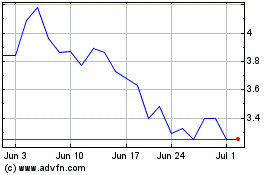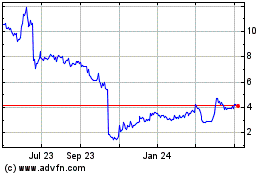- Reproxalap Statistically Lower than Xiidra for the Two
Endpoints of the Trial: Ocular Discomfort (p=0.002) and Ocular
Itching (p=0.01)
- Results Consistent with Data from Post-Acute Ocular
Tolerability Comparison of Reproxalap and Xiidra in Patients with
Dry Eye Disease
Aldeyra Therapeutics, Inc. (Nasdaq: ALDX) (Aldeyra), a
biotechnology company discovering and developing innovative
therapies for the treatment of immune-mediated diseases, today
announced positive top-line data from a Phase 2 clinical trial
comparing ocular discomfort and itching symptom scores of
reproxalap ophthalmic solution 0.25% (reproxalap), an
investigational new drug, versus Xiidra® (lifitegrast ophthalmic
solution 5%) in patients with dry eye disease. Patient-reported
ocular discomfort (p=0.002) and itching (p=0.01) were statistically
lower with reproxalap than with Xiidra.
This press release features multimedia. View
the full release here:
https://www.businesswire.com/news/home/20220110006109/en/
Aldeyra Therapeutics, Inc. (Nasdaq: ALDX)
on January 11, 2022 announced positive top-line data from a Phase 2
clinical trial comparing ocular discomfort and itching symptom
scores of reproxalap ophthalmic solution 0.25% (reproxalap), an
investigational new drug, versus Xiidra® (lifitegrast ophthalmic
solution 5%) in patients with dry eye disease. Patient-reported
ocular discomfort (p=0.002) and itching (p=0.01) were statistically
lower with reproxalap than with Xiidra®. (Graphic: Aldeyra
Therapeutics)
“The statistically significant symptom improvement of reproxalap
over Xiidra observed in this trial reinforces the data from an
earlier clinical trial demonstrating tolerability advantages of
reproxalap over Xiidra in patients with dry eye disease,”1 stated
Todd C. Brady, M.D., Ph.D., President and Chief Executive Officer
of Aldeyra. “The combination of rapid activity and improved
tolerability evidenced by reproxalap in clinical testing has the
potential to address significant compliance issues with currently
available therapy, the median discontinuation rates of which are
approximately one month.”2
“The clinically relevant and statistically significant reduction
in symptomatic activity suggest that reproxalap, if approved, has
the potential to become a first-line therapy for the treatment of
dry eye disease,” stated Peter Couroux, M.D., Global Senior Medical
Director for Cliantha Research and the principal investigator of
the clinical trial. “As the first RASP modulator developed for
ocular surface disease, reproxalap represents a new mechanism of
action that may expand the treatment options available to dry eye
disease patients.”
The double-masked, crossover, single-center, Phase 2 clinical
trial in 56 dry eye disease patients evaluated the activity of
reproxalap compared to Xiidra for two endpoints: ocular discomfort
symptom score and ocular itching symptom score. A single dose of
test article was administered to both eyes approximately 5 minutes
prior to a dry eye chamber exposure lasting 45 minutes, during
which humidity was maintained at low levels in a setting of
regulated air flow, temperature, and visual tasking. Symptoms were
assessed approximately 15 minutes prior to chamber entry, and every
5 minutes beginning 5 minutes after chamber entry.
No safety signals were observed in the trial, and there were no
treatment-related discontinuations or moderate or serious adverse
events related to drug. The most common adverse event in both
treatment arms was mild instillation site discomfort. Reproxalap
has now been evaluated in more than 1,500 patients. The approved
commercial dosing regimen of Xiidra and the intended commercial
dosing regimen of reproxalap include repeated administration of
drug.
Aldeyra plans to present data from the trial at an upcoming
medical meeting.
About Reproxalap
Reproxalap, an investigational new drug, is a novel
small-molecule modulator of RASP (reactive aldehyde species), which
are elevated in ocular and systemic inflammatory disease.
Reproxalap’s mechanism of action has been supported by the
demonstration of statistically significant and clinically relevant
activity in multiple physiologically distinct late-phase clinical
indications. Reproxalap is currently in Phase 3 clinical
development as a 0.25% ophthalmic solution for the treatment of dry
eye disease and allergic conjunctivitis, two of the largest markets
in ophthalmology.
About Dry Eye Disease
Dry eye disease is a common inflammatory disease estimated to
affect 34 million or more adults in the United States.3 The disease
is characterized by insufficient lubrication of the anterior
surface of the eye, leading to dryness, inflammation, pain,
discomfort, irritation, diminished quality of life, and in severe
cases, permanent vision impairment. Among many physicians and
patients, existing therapy for dry eye disease is generally
regarded as inadequate and often requires weeks or months to
demonstrate activity. In patients with dry eye disease,
pro-inflammatory RASP may contribute to ocular inflammation and
changes in tear lipid composition.4 By diminishing RASP levels,
Aldeyra’s lead RASP modulator reproxalap represents a novel and
differentiated approach for the treatment of the symptoms and signs
of dry eye disease.
About Aldeyra Therapeutics
Aldeyra Therapeutics discovers and develops innovative therapies
designed to treat immune-mediated diseases. Our approach is to
develop therapies that modulate immunological systems, instead of
inhibiting or activating single targets, with the goal of
optimizing multiple pathways at once while minimizing toxicity. Two
of our lead product candidates, reproxalap and ADX-629, target
pre-cytokine, systems-based mediators of inflammation known as RASP
(reactive aldehyde species). Reproxalap is in Phase 3 clinical
trials in patients with dry eye disease and allergic
conjunctivitis. ADX-629, an orally administered RASP modulator, is
in Phase 2 proof-of-concept clinical trials in psoriasis, asthma,
and COVID-19. Our pipeline also includes ADX-2191 (intravitreal
methotrexate 0.8%), in development for the prevention of
proliferative vitreoretinopathy and the treatment of retinitis
pigmentosa and primary vitreoretinal lymphoma. For more
information, visit https://www.aldeyra.com/ and follow us on
LinkedIn, Facebook, and Twitter.
Safe Harbor Statement
This release contains forward-looking statements within the
meaning of the Private Securities Litigation Reform Act of 1995,
including, but not limited to, statements regarding Aldeyra's
strategy, future operations, prospects, plans, and objectives and
Aldeyra's plans and expectations for its product candidates,
including reproxalap. Aldeyra intends such forward-looking
statements to be covered by the safe harbor provisions for
forward-looking statements contained in Section 21E of the
Securities Exchange Act of 1934 and the Private Securities
Litigation Reform Act of 1995. In some cases, you can identify
forward-looking statements by terms such as, but not limited to,
"may," "might," "will," "objective," "intend," "should," "could,"
"can," "would," "expect," "believe," "anticipate," "project," "on
track," "scheduled," "target," "design," "estimate," "predict,"
"potential," "aim," "plan" or the negative of these terms, and
similar expressions intended to identify forward-looking
statements. Such forward-looking statements are based upon current
expectations that involve risks, changes in circumstances,
assumptions, and uncertainties. Aldeyra is at an early stage of
development and may not ever have any products that generate
significant revenue. All of Aldeyra's development timelines may be
subject to adjustment depending on recruitment rate, regulatory
review, preclinical and clinical results, and other factors that
could delay the initiation or completion of clinical trials.
Important factors that could cause actual results to differ
materially from those reflected in Aldeyra's forward-looking
statements include, among others, the timing of enrollment,
commencement and completion of Aldeyra's clinical trials; the
timing and success of preclinical studies and clinical trials
conducted by Aldeyra and its development partners; updated or
refined data based on Aldeyra's continuing review and quality
control analysis of clinical data, Aldeyra's ability to design
clinical trials with protocols and endpoints acceptable to
applicable regulatory authorities; delay in or failure to obtain
regulatory approval of Aldeyra's product candidates; the ability to
maintain regulatory approval of Aldeyra's product candidates, and
the labeling for any approved products; the risk that prior
results, such as signals of safety, activity or durability of
effect, observed from preclinical or clinical trials, will not be
replicated or will not continue in ongoing or future studies or
clinical trials involving Aldeyra's product candidates in clinical
trials focused on the same or on different indications; the risk
that the results from earlier clinical trials, portions of clinical
trials, or pooled clinical data may not accurately predict results
of subsequent trials or the remainder of a clinical trial; the risk
that results from comparative clinical trials, such as ocular
discomfort and itching comparisons, may not be replicated with
repeated administration of drug as directed by the intended
commercial dosing regimen and the commercial dosing regimen, as
applicable; the scope, progress, expansion, and costs of developing
and commercializing Aldeyra's product candidates; uncertainty as to
Aldeyra’s ability to commercialize (alone or with others) Aldeyra's
product candidates following regulatory approval, if any; the size
and growth of the potential markets and pricing for Aldeyra's
product candidates and the ability to serve those markets;
Aldeyra's expectations regarding Aldeyra's expenses and revenue,
the sufficiency or use of Aldeyra's cash resources and needs for
additional financing; political, economic, legal, social and health
risks, including the COVID-19 pandemic and related public health
measures, that may affect Aldeyra’s business or the global economy;
the rate and degree of market acceptance of any of Aldeyra's
product candidates; Aldeyra's expectations regarding competition;
Aldeyra's anticipated growth strategies; Aldeyra's ability to
attract or retain key personnel; Aldeyra’s limited sales and
marketing infrastructure; Aldeyra's ability to establish and
maintain development partnerships; Aldeyra’s ability to
successfully integrate acquisitions into its business; Aldeyra's
expectations regarding federal, state and foreign regulatory
requirements; regulatory developments in the United States and
foreign countries; Aldeyra's ability to obtain and maintain
intellectual property protection for its product candidates; the
anticipated trends and challenges in Aldeyra's business and the
market in which it operates; and other factors that are described
in the "Risk Factors" and "Management's Discussion and Analysis of
Financial Condition and Results of Operations" sections of
Aldeyra's Annual Report on Form 10-K for the year ended December
31, 2020 and Quarterly Report on Form 10-Q for the quarter ended
September 30, 2021, which are on file with the Securities and
Exchange Commission (SEC) and available on the SEC's website at
https://www.sec.gov/. Additional factors may be described in those
sections of Aldeyra's Annual Report on Form 10-K for the year ended
December 31, 2021, expected to be filed with the SEC in the first
quarter of 2022.
In addition to the risks described above and in Aldeyra's other
filings with the SEC, other unknown or unpredictable factors also
could affect Aldeyra's results. No forward-looking statements can
be guaranteed and actual results may differ materially from such
statements. The information in this release is provided only as of
the date of this release, and Aldeyra undertakes no obligation to
update any forward-looking statements contained in this release on
account of new information, future events, or otherwise, except as
required by law.
1 McMullin D, Clark D, Cavanagh B, Karpecki P, Brady TC. A
Post-Acute Ocular Tolerability Comparison of Topical Reproxalap
0.25% and Lifitegrast 5% in Patients with Dry Eye Disease. Clin
Ophthalmol. 2021 Sep 22;15:3889-3900.
2 White DE, Zhao Y, Ogundele A, Fulcher N, Acs A, Moore-Schiltz
L, Karpecki PM. Real-World Treatment Patterns Of Cyclosporine
Ophthalmic Emulsion And Lifitegrast Ophthalmic Solution Among
Patients With Dry Eye. Clin Ophthalmol. 2019 Nov
22;13:2285-2292.
3 Paulsen AJ, Cruickshanks KJ, Fischer ME, Huang GH, Klein BE,
Klein R, Dalton DS. Dry eye in the beaver dam offspring study:
prevalence, risk factors, and health-related quality of life. Am J
Ophthalmol. 2014 Apr;157(4):799-806. doi:
10.1016/j.ajo.2013.12.023. Epub 2014 Jan 2. PMID: 24388838; PMCID:
PMC3995164.
4 Choi W, Lian C, Ying L, Kim GE, You IC, Park SH, Yoon KC.
Expression of Lipid Peroxidation Markers in the Tear Film and
Ocular Surface of Patients with Non-Sjogren Syndrome: Potential
Biomarkers for Dry Eye Disease. Curr Eye Res. 2016
Sep;41(9):1143-9. doi: 10.3109/02713683.2015.1098707. Epub 2016 Jan
5. PMID: 26731289.
View source
version on businesswire.com: https://www.businesswire.com/news/home/20220110006109/en/
Corporate: Joshua Reed Aldeyra Therapeutics, Inc. Tel:
781-761-4904 ext. 218 jreed@aldeyra.com
Investors & Media: Scott Solomon Sharon Merrill
Associates, Inc. Tel: 617-542-5300 ALDX@investorrelations.com
Aldeyra Therapeutics (NASDAQ:ALDX)
Historical Stock Chart
From Mar 2024 to Apr 2024

Aldeyra Therapeutics (NASDAQ:ALDX)
Historical Stock Chart
From Apr 2023 to Apr 2024
